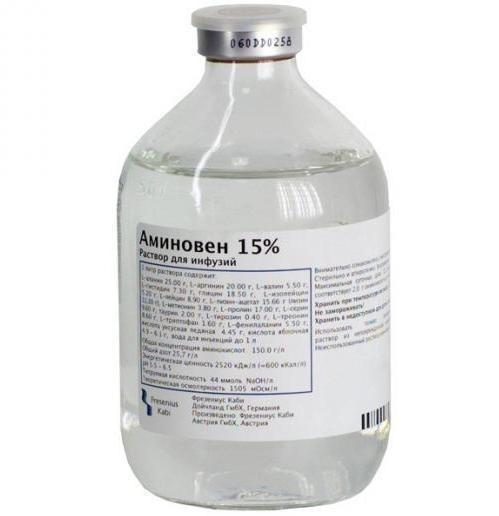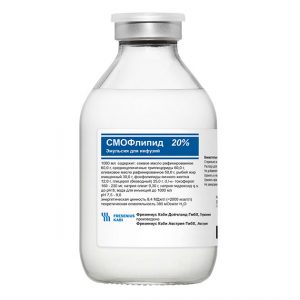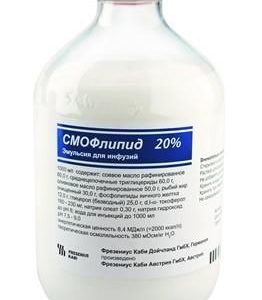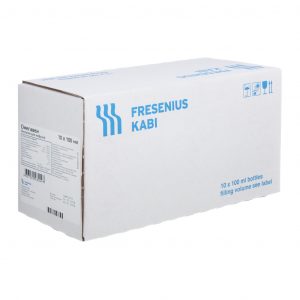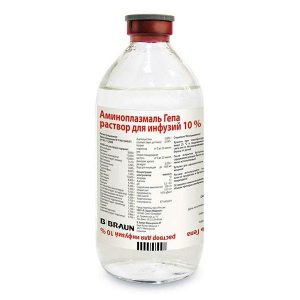Description
Latin name
Aminoven
Packaging
In a package of 10 bottles of 500 ml.
Pharmacological action
Aminoven 15% is intended for parenteral nutrition of patients with various pathologies with low, normal or increased protein requirements when enteral nutrition is ineffective or impossible. The replaceable and irreplaceable L-amino acids contained in Aminoven are natural physiological compounds. Like amino acids that come from food and obtained by splitting proteins, parenteral amino acids enter the general pool of free amino acids in blood plasma, and from it into cells for protein synthesis and into various metabolic pathways.
Indications
Complete or partial parenteral nutrition. Amino acid solutions are usually used in combination with a sufficient number of energy sources (glucose, fat emulsions).
Prevention and therapy of protein loss when oral or enteral nutrition is not possible, insufficient or contraindicated.
Contraindications
Impaired amino acid metabolism.
metabolic acidosis.
Renal failure in the absence of hemodialysis or hemofiltration.
Severe liver failure.
Liquid overload.
shock.
Hypoxia.
Uncompensated heart failure.
Newborns infants and children up to 2 years of age: use adapted infant amino acid preparations, the composition of which is specially designed to meet the metabolic needs of children (Aminoven Infant).
It is not recommended to prescribe Aminoven 15% in children (under 18 years of age) due to the lack of sufficient clinical experience in this age group.
Use during pregnancy and lactation
There have been no special studies of the safety of using Aminoven during pregnancy and lactation. However, clinical experience with the use of similar parenteral solutions of amino acids indicates the absence of risk for pregnant and lactating women. Before administering Aminoven, pregnant or lactating women should assess the risk-benefit ratio.
Composition
Active substances: L-isoleucine 5.2 g, L-leucine 8.9 g, L-lysine acetate 15.66 g (corresponding to the content of L-lysine 11.1 g), L-methionine 3.8 g, L-phenylalanine 5.5 g, L-threonine 8.6 g, L-tryptophan 1.6 g, L-valine 5.5 g, L-arginine 20 g, L-histidine 7.3 g, L-alanine 25 g, glycine 18.5 g, L-proline 17 g, L-serine 9.6 g, L-tyrosine 400 mg, taurine 2 g
Excipients: glacial acetic acid 4.45 g, malic acid (to maintain pH) 4.9 – 6.1 g, water d / and up to 1 l
Dosage and administration
Aminoven 15% should only be injected into the central veins. The infusion can be continued for as long as the clinical condition of the patient requires, based on the daily requirement for amino acids.
Adults
Average daily dose: 6.7-13. 3 ml of Aminoven 15% per kg of body weight (equivalent to 1.0-2.0 g of amino acids per kg of body weight), which corresponds to 470-930 ml of Aminoven 5% for a patient with a body weight of 70 kg.
Maximum daily dose: 13.3 ml Aminoven 15% per kg body weight (equivalent to 2.0 g amino acids per kg body weight), which corresponds to 930 ml Aminoven 15% for a patient with a body weight of 70 kg.
Maximum infusion rate: 0.67 ml Aminovena 15% per kg body weight per hour (equivalent to 0.1 g of amino acids per kg body weight / h).
Children: It is not recommended to use Aminoven 15% in children (under 18 years of age). Newborn infants and children up to 2 years of age: You should use adapted baby preparations of amino acids, the composition of which is specially designed to meet the metabolic needs of children (Aminoven Infant).
Drug Interactions
Currently, cases of interaction are unknown. Due to the increased risk of microbiological contamination and incompatibility, solutions of amino acids should not be mixed with other drugs. not intended for parenteral nutrition. Aminoven can be mixed with Dipeptiven, strictly observing the rules of asepsis. Do not add other drugs to the mixture.
overdose
Symptoms: Aminovin overdose or an excess of its infusion may lead to chills, vomiting, nausea, increased renal excretion of amino acids.
Too fast infusion can cause fluid overload and impaired electrolyte balance.
Treatment: In case of signs of overdose, the infusion should be stopped immediately. In the future it is possible to resume it at a reduced dosage.
There is no specific antidote for overdose. Emergency measures should be of a general supportive nature, with particular attention to the function of the respiratory and cardiovascular systems. Control of biochemical parameters and appropriate treatment of identified disorders is important.
Storage Conditions
Do not store above +25 ° C. Do not freeze.
Shelf life
2 years.
Deystvuyushtee substance
Aminokislot dlya parenteralynogo queries
Terms and conditions
prescription
dosage form
infusion solution
Appointment Appointment
children on prescription, For adults as prescribed by a doctor
